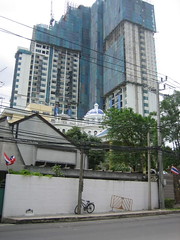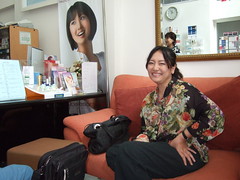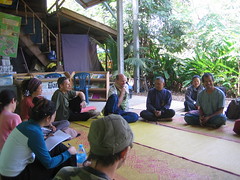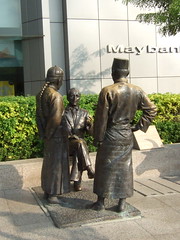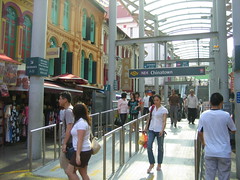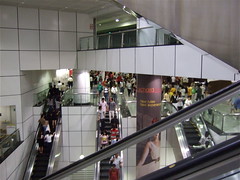Return To Asia III: The Conundrum of Thailand
Having seen Singapore and Kuala Lumpur, I had a much better idea of how Bangkok fit into the context of its urban neighbors and what future it was seeking. Asian cities, I could see, were committed heart and soul to development, the kind of development that would embrace its citizens in a sort of universal standard of modern design.
Bangkok was cleaner and more upscale than I remembered it being. The old grimy cement block shop fronts of the 50s and 60s that had sold sundries, made-to-order garments and locally made house wares had been remodeled into brightly lit modern stores—a 7/11, a copy shop, a hair salon. On my street a store front was being finished with reflection pools set between squares of granite. The glass front allowed the office to be seen with all of its artwork and black leather and chrome furniture. Soon it would sell condominiums not yet built, but slated for development on the empty lot behind the new office.
The message was clear. The old would make way for the new and it would all be good. This growth was the way to raise all boats. The endless supply of raw materials transformed into chrome and glass enclosed buildings, full of cool air and new furnishings, blended right into the better living commercials playing endlessly on the Sky Train. I was stymied by this growth driven sensibility in Asia, but here in Thailand there was a pause, as the recession ate away at this message and the political winds shifted, battering the country in civic unrest.
Protestors in Thailand had shut down the airport for a week last November, then in April a counter group supporting Thaksin, the deposed prime minister, had trashed the hotel of the ASEAN Summit meeting and shut it down. The coup, two years ago that had deposed said prime minister, still raised the question in the eyes of Western journalists of whether Thailand would hold onto democracy. When Thaksin was mentioned, in the Western press, he was described with the phrase "democratically elected populist" which ostensibly made him the good guy while his crimes of corruption were minimized. I knew about the vote buying and the empty populist promises Thaksin Shinawatra had made to the poor. His economic policies had earned the nickname Thaksinomics. His plans for massive development projects would have further robbed the poor of their land rights, sending more to seek employment in the city (and yes more girls to the sex trade). What I didn't get was why the poor spoke of Thaksin with such affection even after he was ousted from power.
I took the opportunity to ask one of my contacts in Bangkok. Teng a business owner and dentist, had opened her own clinic offering plastic surgery and other beauty enhancement services for the face. Her clientele were largely Japanese ladies traveling to Thailand for the comparatively inexpensive procedures. My mother was quite curious to see what they offered and sought out a consultation. This was easily arranged through the school friends network. Teng sent her driver the short distance to pick us up at my house. As I sat waiting in the lobby of the clinic store front I asked Teng if she supported Thaksin.
"I don't like people who cheat," she said simply. Yes, he had cheated to such an extent that the term corruption was not enough to describe the heights to which he had used his position for his own monetary gain. His people had been blatant about offering government contracts on the condition that they got half the money budgeted for any single project. Companies whose income relied on government contracts were sucked in. When the coup came, the business class was suddenly divided and individuals who would normally trust each other found they had to walk on eggshells, unsure of who was on what side until the courts sorted it out.
There were still supporters of Thaksin in Thailand, said to be the rural poor, who were behind the recent protests. I asked Teng why he was so popular with the poor. She only took a moment to answer as if something unusual had happened.
"He let people touch him," she said, "no political candidate allowed poor people to touch them before. Thaksin did like a movie star and that made him popular. Even now the leaders won't let people touch them" she added as if they should have learned something.
This explanation neatly filled my curiosity. It explained the odd sentiment I had heard reported from one senior lady when Thaksin returned to Bangkok last year for his trial. She said she loved Thaksin because he was so cute. Cute had never been a word associated with political leaders before; it just cut too deeply into class taboos.
Thaksin was still in contact with his supporters while in exile, sending them video links pleading with them to fight for his pardon; he addressed them as peers and even sang to them. His supporters wore red, an angry color that filled the streets when they protested. Having inspired them to assemble, he called in on cell phones during the rallies to egg them on. You can see it all on YouTube. Thaksin had indeed made like a movie star. The rural poor were usually loyal to the King who was extremely revered all over the country.
The counter protestors wore yellow, the King's color. They were said to be a group comprised of royalists. Western reporters could not seem to get past this term to actually discuss what they stood for. Royalists were automatically suspect as if they were plotting to bring back an absolute monarchy, which even the King did not want. A writer for the Economist railed against the law of lese majesty that forbids citizens from openly criticizing members of the royal family, claiming that this seriously hampered democratic proceedings. I was annoyed by his tone. He did not seem to know anything about what the King stands for in Thailand.
During our trip I came across a posted sign that illuminated my own feelings about the King and his relationship to Thailand. We were visiting Pattaya, a seaside resort not far from Bangkok. My family had often spent weekends there when I was a child. It had been a quiet one-hotel town full of beach houses belonging to the wealthy. Now it was a densely developed strip of shoulder-to-shoulder, high rise hotels and sleazy, pick-up bars. The beach, however was still open to the public. I remembered, as a child, that no house, no matter how wealthy the owners, was allowed to be built directly on the beach. The reason given was that the beach belonged to the King. How lovely that the King liked the beach so much, I thought, and that he let everybody use it.
While walking the boardwalk at Pattaya, that weekend, I noticed a sign posted in a police sentry box, urging people not to throw garbage or cigarette butts on the beach. The sign was in Thai and English and the words "Keep it clean for the King," caught my eye. Underneath in smaller type was added "and safe for children and wildlife". Suddenly it came to me. The King was not coming to the beach anytime soon. He was a symbol representing the commons. He supported the interests of the people so the people returned the favor and called themselves supporters of the King because he supported them. Didn't anybody get it? Did the West even have a symbol of the commons? I wondered.
I was intrigued by the return to royalist sentiments. What were they after that the King in turn would support? The royal family denied any connection with the group. The King himself was quite feeble now and did not often leave his residence in Hua Hin (another beach resort). How his successor would do and if he would garner the same respect as his father was a question on all our minds. There was some talk, said a friend, of not having a royal family at all. But that, I thought, was getting a little ahead of ourselves.
The royalists protestors were for a "reasonable society" I read in wickipedia. They wanted a nation with less consumer debt and less concern with material goods. They opposed foreign investment and privatization of state enterprises. No wonder they were a threat to the writers of the Economist. It sounded like they were against the very underpinnings of globalization.
Western democracy, as I saw it being used today, was a platform for the elected wealthy of countries like Thailand to negotiate deals with the big players of the global market while making themselves even more rich. Americans, too, have wrestled with this question of corruption. In a recent poll a majority said that they would be more likely to trust representatives that were randomly selected from the phone book than those currently in Congress now.
I knew from Nor and Raja that there was sympathy for the royalists, but it was difficult to embrace them since they were somewhat extreme. They were asking for leaders to be royally appointed in an attempt to sidestep the corruption of democratically elected officials. Their takeover of the airport was an amazing show of power that had gone unpunished. It was hard to tell where their now bolstered confidence might lead them.
I did not press Teng for any more information and instead took a picture of her. She gave me her best side then surveyed my face suggesting that one of her doctors could easily zap that large freckle off my upper cheek. Yes, it looks like some kind of cancer my mother said and there was another one nearly as big on the other cheek. Teng named her price for two freckles—only $18. Done, I said, wondering what the US might learn here about lowering the cost of medical services. (Prescription drugs, too, were half the price my mother discovered when she went to buy her blood pressure medicine.)
In the end I was left wondering how this ultra modern, luxury oriented urban population would reconcile their needs with those of the nation and the poor. My mother and I did see children and adults begging at the foot of the escalator to the Sky Train station. We saw one small boy by himself, hardly moving. In front of him a plastic water bottle cut in half for coins offered. He was still there when we returned after dark. It brought to mind the movie Slumdog Millionaire which I had liked so much because it affirmed my reality by showcasing, so unapologetically, the poverty I witnessed growing up.
These destitute, in the context of an Asian city, would easily clean up per the Asian commitment to growth. Just park them in tenements and press them for cheap labor in factories. (Factories are, of course, dependent on consumer demand and many had closed this year.)
I preferred another picture of the poor. I recently discovered the classic Foxfire series of books produced in the 70s by American high school students in the state of Georgia. In them students interviewed "old timers" who still lived in the Appalachian Mountains and survived by methods of self-sufficiency duly recorded by the students in photographs. In the context of modern life these Appalachians owned very little and nothing that could be called modern i.e.: a TV or electricity for lights. Their way of life was dependent on the land around them just as were the Thais I met last year, on my trip to visit examples of sustainable solutions in rural Thailand. Both could not live without the land. Neither had asked to be modernized. Both favored self-sufficiency.
I would not forget meeting, on that trip, three men who had joined the Assembly of the Poor to demand compensation for the drowning of their land by the Pak Man dam project. They were forest dwellers who made a living foraging and caring for the forests. I came to understand how protest follows development because access to land is stolen from the poor.
I was also taken by the Buddhist group known as the Santi Asoke who taught skills of self-sufficiency after the economic collapse of '97, to anyone who came to them. The Santi Asoke Buddhists had originally protested Thaksin on moral grounds leading to more widespread protests until finally the military stepped in to oust Thaksin, ostensibly to prevent further unrest and complete chaos. The Santi Asoke Buddhists now supported the royalists, a more well heeled version of the original group that led to the ousting of Thaksin. (Along with the royalists were members of the middle class and business elite.) I was glad to see my narrative thread had not been broken. It just needed a resolution.
Would the rich relinquish some of their hold on the resources milked from the lands of the poor? Would Thailand stand up to the destructive forces of globalization stripping resources for profit? Would it morph itself a government that could actually temper development while promoting self-sufficiency and creativity? What kind of society would come out of this grass roots activism and civil unrest? Though each bit of news from Thailand now filled me with dread I couldn't wait for the next installment.
Labels: Asia, politics, sustainability, Thailand, travel
